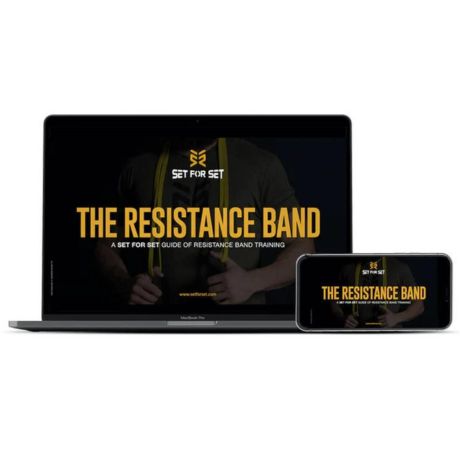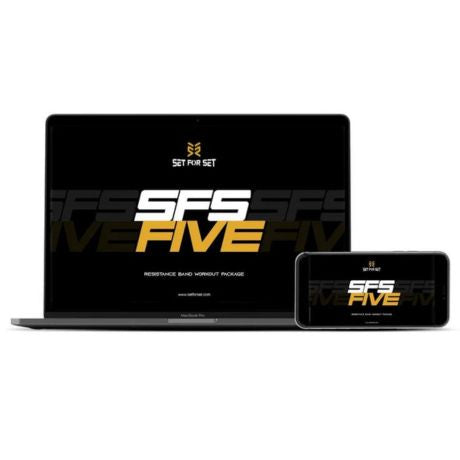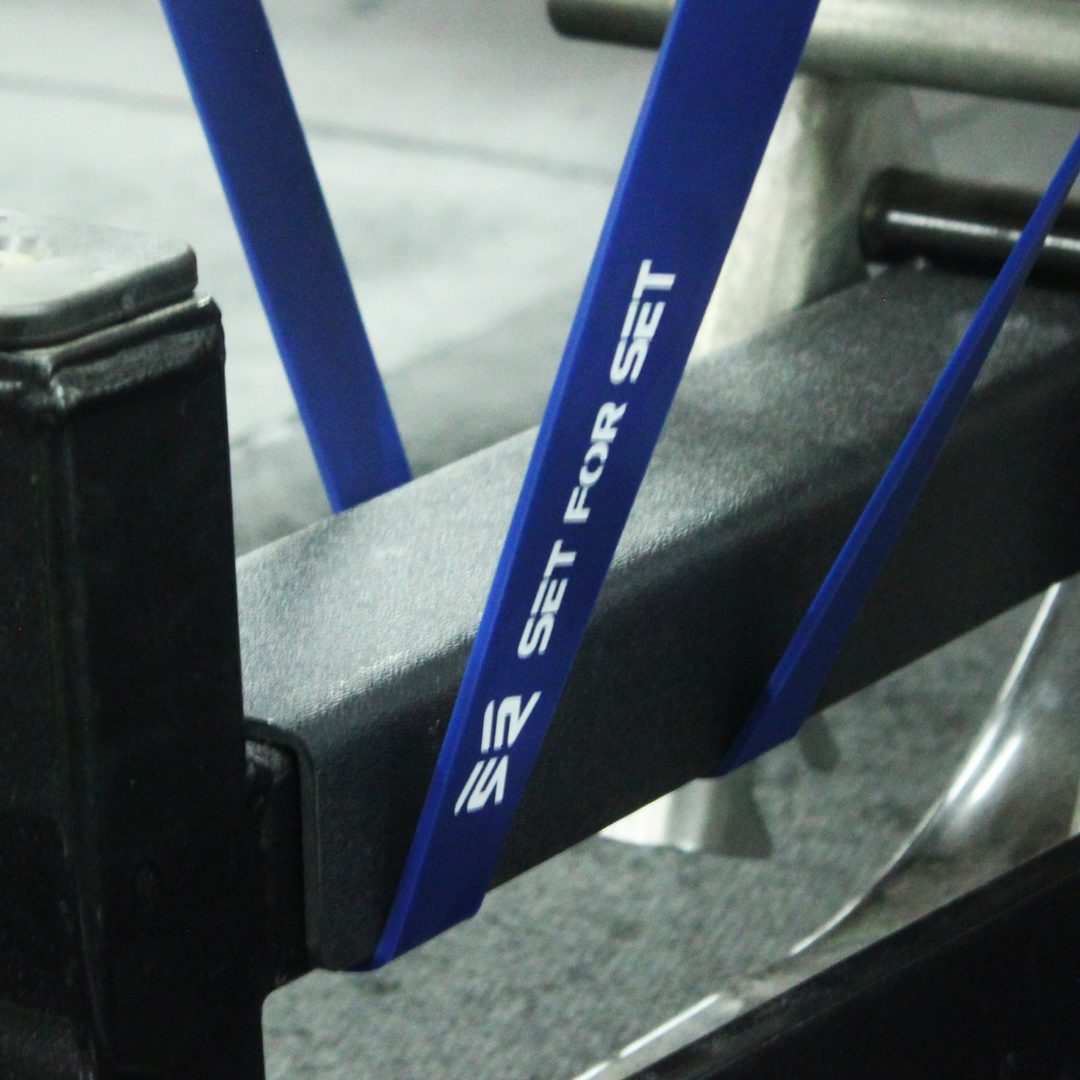Lifting with resistance bands is a no-gimmick strength training method used by the greatest powerlifters across the globe. By combining resistance bands with your barbell lifts, i.e. Banded Squats, Banded Deadlifts, Banded Bench Press, and Banded Military Press, you can take your power and explosion to the next level (it's all about eliminating those strength curves!).
In this article, you are going to learn why you should add resistance bands to your weight lifting sessions and we are going to show you exactly how to do it.
Take Your Fitness To The Next Level

What type of bands for barbell powerlifting?
Before we begin, we just want to make it clear that you need a specific type of resistance band for barbell lifts. You want 41 inch loop resistance bands, aka power bands. This is the only band that you can combine with barbell exercises. These are the types of bands we are talking about:
The great thing about these resistance bands is, they are so versatile. You can use power resistance bands in so many ways.
Related: The Best Powerlifting Workout Program
Strength Training with Resistance Bands
Technique is everything when you are strength training. Without it, you can kiss goodbye any chance of being a muscle-bound Adonis. But, what does "technique" mean exactly?
You might think to have "technique" means just having proper form during your workout. However, there is more to it than just that. Your technique also includes the equipment you use and how you use them (exercises, protocols, and methods).
You need to figure out a way to continually progress, maximize tension and muscle fiber recruitment, and create more effective workouts if you want to take your intermediate strength and power to a more advanced level.
One of those ways is with bands and chains...
You may have noticed some intense bodybuilders, weightlifters, and powerlifters at the gym (or on IG) using chains and bands.
What's the purpose of these implements?
With chains, you get an added element of stability training, as they dangle and sway when you lift, and you get a bit of a strength curve elimination, as when you are in the lowest phase of the lift, the chains are partially on the floor, which takes away some of their resistance, then when you come up, they are completely off the floor, allowing them to add their full weight to the barbell, which adds resistance to the easiest part of the lift (the top of the movement)...looking badass is just a bonus.
With bands, you can eliminate the strength curve too, just in a different, more effective manner, you can work on explosiveness, and you can also use them for stability by looping them through a plate or kettlebell and then hang them from the sleeves of the barbell...the best part is, they are a lot more portable than some 100+ pound chains!
This will all make sense as we provide some key examples further below...

WHY YOU SHOULD COMBINE RESISTANCE BANDS WITH BARBELL LIFTS
It's easy to overlook resistance bands as an effective solution for increasing both strength and hypertrophy gains, being that resistance bands are typically a forerunner fitness item used in most beginner-level workout videos and programs or for people who exercise at home. This makes some people think bands are not suitable when you get to an intermediate level.
BUT, don't let these oversized rubber bands fool you!
Resistance bands might just be the addition your strength training workouts have been missing. If used correctly, bands will allow you to achieve a more advanced level of training...
But, how?
Let us explain...
1. Using Resistance Bands for Ascending Barbell Strength Exercises
Most people use power resistance bands and chains to help intensify and make more effective any exercise that has ascending strength curve.
If you're not overflowing with bulking knowledge of strength curves, you probably have no idea what this means...
Let's explain strength curves and then get into how bands come into play.
Essentially, you can breakdown free weight exercises into three specific strength curves: ascending, bell-shaped, and descending. Each one differs based on the point of stress put on the muscles during each rep.
- Ascending Strength Curve - Any workout that feels easier and less tense on your muscles when you reach full extension, you consider it an ascending strength curve. Often, you might associate these with workouts like the leg press, squat or even bench press. When you complete the movement in full extension, you put less strain on your muscles.
- Parabolic/bar-shaped/concave Strength Curve - Infusing both ascending and descending strength curves, this strength curve offers you relief during both full extension and full flexion. You'll begin the workout using minimal tension, use most of your muscle during the middle of the rep and decrease as you finish to the other endpoint. Bicep curls are a popular example of a concave strength curve.
- Descending Strength Curve - Any exercise that requires more tension during full flexions, such as leg curls, are considered descending strength curves. Unlike ascending strength curve, which decreases tension throughout the range of motion, the descending curve increases the tension throughout the workout, until you finish the rep.

By adding bands to the lift, whether that's a barbell squat, bench press, deadlift, or military press, you can eliminate the ascending strength curve.
This is because bands create more resistance as they stretch (elastic tension 101). So, when a free weight lift gets easier towards the top of the movement, like all ascending strength curve exercises do, the bands will be adding more and more resistance since they are anchored from a low point. Ergo, the movement doesn't get easier as your joints reach full extension. You get consistent tension on your muscles throughout the movement. This helps you gain strength towards the top of the lift, not just the bottom, and it promotes explosive power.
Let's take barbell squats as an example. A barbell squat will be the hardest when you are in the lowest position, coming up from the squat. If you have bands attached to the barbell on both sides during the squat, from a low anchor point, there will not be so much tension caused by the band in this low position, as the band isn't stretched much. So, while the band will add some resistance in this low position, it is not significant enough to make this low phase of the squat too difficult to come up from. However, as you keep coming up from the squat, the band starts to stretch more, adding more and more resistance. At the same time, the weight of the barbell (which is caused by gravitational force) is becoming easier, because your joints are in a more optimal range (the top of the movement is always easiest with barbell squats and other ascending strength curve lifts). Thus, the bands make the top of the lift feel about as difficult as the squat did at the bottom.
Put simply, the band adds resistance to the barbell squat in the top phase of the movement, where it is most needed, creating consistent tension and force throughout the entire lift.
This helps trainees build strength in the range of motion that is normally hard to build strength in, because if you were to put a load on the barbell that challenged you in this top position (your strongest range), you wouldn't be able to come up from the squat as it would be too heavy in the lowest phase of the movement (your weakest range).
Making sense?
This technique allows powerlifters, and anyone who employs it, to build strength through each phase of a lift evenly. By doing so, you are sure to break new PRs and become more explosive!
How much weight does a resistance band add to barbell exercises?
Attaching resistance bands to a smith machine or barbell using a squat rack can add as much as 170-pounds of resistance to the lift, depending on the size of the band.
41 Inch Power Band Sizes and Resistance Added:
Yellow (1/2") - 10 to 35 Pounds (Lowest resistance)
Black (3/4") - 30 to 60 Pounds
Blue (1.25") - 40 to 80 Pounds
Green (1.75") - 50 to 125 Pounds
Gray (2.5") - 65 to 170 Pounds
The low range is when the bands are less taut, the high range is when the band is stretched more. So, at peak stretch, a gray 2.5 inch wide band can add a total of 170 pounds! Thus, at the bottom of the squat, it is adding around 65 pounds, and at the top of the squat, it's adding 170 pounds.
Needless to say, start with a light band when adding resistance bands to your barbell lifts and test out how it feels.
2. Using Bands for Stability Training
Eliminating strength curves, adding resistance, and maximizing tension & time under tension on the muscles is not the only effective way to use bands with barbells. You can also use them for stability training.
You can improve stability with resistance bands by looping a weighted plate through the bands then hanging them on both sides of the bar, as seen below. This can be done for any barbell lift, like squats, bench press, or military press. This is a great way to strengthen your stabilizer muscles, which, in turn, will help you become stronger and more stable in your heavy lifts (new PRs, baby!).

The Startup: Beginning Your Barbell Workouts with Resistance Bands
Transitioning from free weight-only workouts to free weight and resistance band workouts takes some practice for beginners. You may want to continue lifting the same amount of weight load when you first start with banded squats, bench press, or the like.
However, this is obviously not smart since the bands change the lift in a considerable way. They don't just add resistance, they also pull you down (which is great for building strength in the eccentric phase of the lift too by the way), so you need to remain very firm at all times.
The point is, you should go down in weight when adding resistance bands to the bar.
If you are a beginner to banded barbell lifts, it's recommended to start with no plates at first, just to get a feel for it.
Practice with just the resistance bands on the barbell. It'll feel surprisingly different.
After you do a set or two, determine approximately how much tension the bands added and the amount of extra weight from plates you can handle during each set (if you've be weightlifting for a while, you intuitively know).
Start off with a low weight regardless of how confident you are, then slowly build your way up until you reach an ideal weight load that works for you.

Warning
Keep in mind that your resistance bands need to be balanced equally on both sides. If the band adds more tension on one side, it will cause an uneven workout.
So, again, it's important to test the banded barbell lift without plates first.
Also, remember to keep enough tautness on the band during the bottom portion of your movement. You don't want the band to have slack in it at any point during the lift.
Now, here are a few exercises involving an ascending strength curve that can increase your results while using a resistance band.

Our guide has over 250 exercises categorized by mobility, mobilization, resistance training, barbell training, explosive training, static stretching, and (p)rehabilitation...
6 Ways to Use Resistance Bands for Strength Training With Barbells
1. Leg Press with Resistance Bands
During a leg press, you'll need to have two fitness bands on you since one won't always fit the full length. Tie together two resistance bands, centering it behind the seat. Take each strap and connect them to the closest side of the plate rack. Shorter individuals may find the lower plate rack better, while those taller may need the upper plate rack pegs to attach the bands. Trying out the leg press with just the band will help you determine which one helps add the most tension to your workout.
2. Bench Press with Barbell and Resistance Bands
On the bottom of your bench press, you'll notice a little bar underneath it that curves. Use this to hold one portion of the band and bring the other end to the end of the barbell. Use another and do it on the other side of the barbell (remember, equal distribution matters).
As you move upward to full extension, you'll feel the added resistance that helps pump your muscles even more. As you work your way down to full flexion, the bands should still add some slack to the bar to keep them securely on the barbell.
3. Deadlift with Resistance Bands
Put the loops of your two bands on the inside of the weights for the deadlift. This will help secure the bands onto the bar without it constantly falling off since there is no way to add slack during the end movement of the deadlift. Find an anchor point that's low on the ground to attach both sides (usually two small poles near the bottom of the deadlift). For added tension, stand on any platform box.
4. Squat with Bands
This exercise involves uses dumbbells, a squat rack or kettlebells as an anchor point. If you have a squat rack, attach the ends of each band to an anchor point and then place the other ends on the bar before putting the weighted plates on. If you're freestyling your squats, run the end of the band around the dumbbell or kettlebell handle. Next, you take the other end and run it through the loop to fully attach and secure the handles. Take the free end and wrap it around the bar before the plates. This will fully secure it during the entire motion.
5. Shoulder Press with Resistance Bands
Attach one end of each resistance band to an anchor point (usually a bar below the seat). Attach the other ends to the bar and add weight as needed, keeping the bands on the inside of the bar.
How to set bands up for power lifts & strength training?
Here is an example of a simple set up if you have a squat rack.


6. Crazy Bells - Stability Training

Simply attach a weighted plate or a kettlebell to a band, then loop the other side of the band on the barbell sleeve. Do the same for the other side (you'll need two bands of the same size). The bands will be dangling down from the ends of barbell. Then, perform the exercise as you normally would, but we must warn you, it's going to feel totally different with the bands/plates dangling to the sides. You will really need to focus on stability (go light to start).
Check this article out to see how it's done for bench press: Barbell Chest Exercises with Resistance Bands (it also includes other cool ways to use resistance bands on chest day at the gym).

The SFS FIVE Resistance Band Workout Package has 5 fun and challenging full length workouts using only resistance bands. Each workout targets different muscle groups. Together, the 5 workouts make for the perfect weekly workout routine.
Where to Get the Best Resistance Bands For Strength Training?
At SET FOR SET, we have high quality, heavy duty power resistance bands made for weightlifting. Our prices are as unbeatable as the quality too!
Note: Some exercises require you to have two of these bands so you have added resistance on both ends of the bar. So, you will want pairs of the same size.
SET FOR SET Resistance Bands Sizes & Added Tension:
Yellow (1/2") - 10 to 35 Pounds (Lowest resistance)
Black (3/4") - 30 to 60 Pounds
Blue (1.25") - 40 to 80 Pounds
Green (1.75") - 50 to 125 Pounds
Gray (2.5") - 65 to 170 Pounds (Highest resistance)
If you're just beginning, try with two 10-to-35lb yellow bands, slowly progressing to the bigger sizes. Remember that two 35-pound resistance bands add 70 pounds of weight to the exercise. Likewise, two 120-pound bands equal to 240 added pounds of weight. So, it's best to start off on the smaller end and slowly increase the resistance strength as you become more accustomed to the workout.
More Resistance Band Resources:







1 comment
It would have been nice if you had recommended a set of bands and, perhaps, showed how to attach them to a home bench or power rack. There are a lot of bands on the market but many may only be suitable for Pilates and not for bodybuilding or power-lifting.